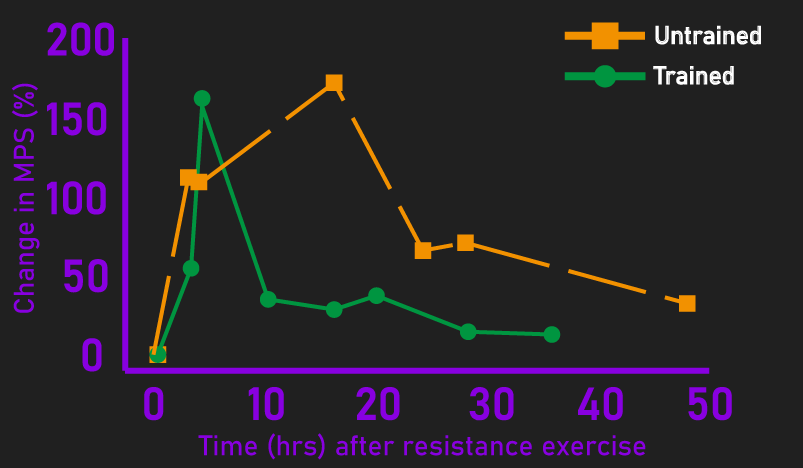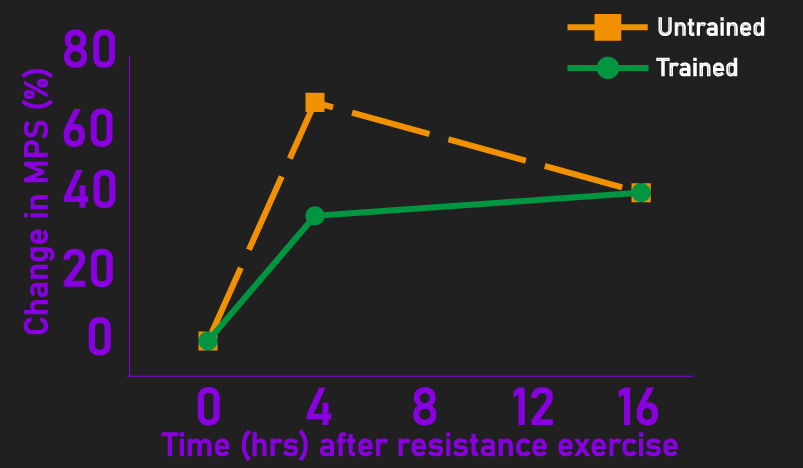
Should you train a muscle with a higher frequency to consistently spike muscle protein synthesis and thereby keep yourself more anabolic.
Using the current science, we’ll assess this.
First and foremost though, what is muscle protein synthesis and why is keeping it elevated important for muscle hypertrophy?
Within your muscles, muscle protein synthesis and muscle protein breakdown are always ongoing.
Muscle protein synthesis is the creation of new muscle proteins, while muscle protein breakdown is the degrading of muscle proteins.
Table of Contents
Bob the builder and Thanos can help us understand this further.
Part I: Bob the Builder X Thanos
Imagine we have a wall. Bob the builder is laying new bricks to the wall.
Thanos, on the other hand, is destroying bricks.

In this analogy, the wall is the muscle, and bob the builder is carrying out muscle protein synthesis (he is adding new bricks), while Thanos is carrying our muscle protein breakdown (he’s destroying bricks).
When bob the builder and Thanos are adding and removing bricks respectively at the same rate, the wall remains the same size.
In correct terms, when muscle protein synthesis is equivalent to the amount of muscle protein breakdown, the muscle remains the same size.
When bob the builder adds bricks faster than Thanos can destroy them, the wall increases in size. That is, when muscle protein synthesis exceeds the rate of muscle protein breakdown, muscle size increases.
Finally, when Thanos destroys bricks faster than bob the builder can add bricks, the wall decreases in size. That is, when muscle protein breakdown exceeds the rate of muscle protein synthesis, muscle size decreases. This unfortunately occurs in aging inactive individuals.
Part II: Higher Frequency for Longer Net Muscle Protein Synthesis?
A resistance training session evokes an increase in muscle protein synthesis and shifts the balance to muscle protein synthesis exceeding muscle protein breakdown.
But how much does muscle protein synthesis rise and last after a resistance training session?
A review study by Damas et al. combined the current data investigating this, and established training experience seems to matter.

For trained individuals, muscle protein synthesis peaks a few hours after a session, and by 10 hours the levels have rapidly fallen.
Untrained individuals peak in muscle protein synthesis elevations close to 20 hours after a session, have a greater area under the curve compared to trained individuals (meaning greater muscle protein synthesis elevations overall), and they also still display fairly decent elevations 40-50 hours after the session.
All this makes sense, untrained individuals have greater muscle growth capacity than trained individuals, resistance training is more novel for untrained folks and is going to disrupt their systems more.
Nevertheless, based on this data, trained individuals might want to train a muscle every other day, while untrained individuals may want to train a muscle every 3rd day.
Doing so would ensure muscle protein synthesis is consistently elevated.
What we’ve just done, examining the timecourse of muscle protein synthesis and deriving training frequency recommendations, is commonly what others do to support the idea of training a muscle more frequently (that is, training a muscle every other day for trained individuals or training every 3rd day for untrained individuals).
But, there are a couple of problems with all of this.
Before moving on, if you’re curious about creating an effective training program for muscle hypertrophy, our high quality partner Alpha Progression can help. It can generate a highly effective program for you, track your workouts live with in-built progression recommendations, provide graphs displaying your long term progress, and it has a massive exercise database with more than 550 exercises.
Click HERE (the link opens in a new tab) to get a free 2 week trial of the apps features. If you like it and go beyond, the link also gives you 20% off a subscription!
We never promote trash at the House of Hypertrophy, so rest assured the app is high quality. The reviews speak to this, 4.8 starts (based on more than 7,000 reviews) on Google play, and 4.9 stars in Apple’s store (based on nearly 400 ratings).
Part III: It’s Not So Simple
Firstly, the data formulating the timecourse of muscle protein synthesis elevations for trained and untrained individuals comes from studies looking at mixed muscle protein synthesis.
Mixed muscle protein synthesis includes all the proteins within muscle fibers, much of these proteins are not involved in muscle hypertrophy.
We care about myofibrillar proteins, the contractile proteins within muscle fibers that produce muscle force. It’s an increase in the number of contractile proteins that conventionally signifies hypertrophy.
Returning to the Bob the builder and Thanos analogy, it’s most accurate to say when myofibrillar protein synthesis exceeds myofibrillar protein breakdown, we then get an increase in muscle size.
Here’s the thing, myofibrillar protein synthesis and mixed muscle protein synthesis do not correlate with each other.
Demonstrating this, Burd et al. had subjects perform the leg extension for 4 sets of repetitions to failure with either a 90% or 30% one-rep max load. 24 hours after this, mixed muscle protein synthesis levels were unchanged, but myofibrillar protein synthesis levels were significantly elevated.
Therefore, it makes no sense to use mixed muscle protein synthesis data to derive training frequency recommendations.
This begs the question: what does the myofibrillar protein synthesis response look like after a resistance training session?
The Damas et al. review study combined two studies and established this graph. The time course of myofibrillar protein synthesis elevations were similar between trained and untrained individuals (it peaked 5hrs after training), but the magnitude of elevation was lower in trained individuals.

For both trained and untrained folks, myofibrillar protein synthesis was still elevated 16 hours after training.
Unfortunately, neither of the two studies involved in this graph established when myofibrillar protein synthesis returned to baseline.
Does any other data help us out?
Before trying to answer this, there is yet another problem on our hands.
Myofibrillar protein synthesis elevations are also impacted by the amount of muscle damage present.
A different study by Damas et al. found across 10 weeks of resistance training, much of the myofibrillar protein synthesis elevations in the initial training sessions were likely directed mainly towards repairing muscle damage and not building muscle.
However, as muscle damage levels gradually decrease as the training weeks go by (this is thanks to the body producing adaptations that make you resilient to muscle damage), the myofibrillar protein synthesis elevations after training was correlated with muscle hypertrophy.

To rephrase all of this, when muscle damage levels are very high (as they would be when you first expose yourself to a novel training stimulus), much of the myofibrillar protein synthesis elevations are directed to repairing damage, not building muscle.
But when muscle damage levels are low or non-existent, then myofibrillar protein synthesis elevations correlate with muscle hypertrophy.
What this means is if we want to establish the time course of myofibrillar protein synthesis elevations that are directed towards building muscle, we’re going to want to look at data that has ensured muscle damage is low or non-existent.
Two papers have technically done this.
The aforementioned Damas et al. study found after a training session in the 10th week of training (a time point at which muscle damage was low), myofibrillar protein synthesis was still elevated 48 hours after the session. The researchers unfortunately did not take any more measures after 48 hours.
Another study by Miller et al. had subjects perform one-legged kicking on specialized equipment for one hour at 67% of their maximum workload.
This protocol caused no signs of muscle damage, probably because I think it was purely concentric resisted training.
Myofibrillar protein synthesis was still elevated 72 hours after the session. Unfortunately, no further measures were taken after 72 hours.
Therefore, from this limited data, myofibrillar protein synthesis (when corrected for muscle damage) seems to last at least up to 48-72 hours after training.
On the whole though, it’s clear to see it’s more or less impossible to derive training frequency recommendations from the current research examining myofibrillar protein synthesis.
Part IV: We’ve Made Assumptions and Ignored Something
We’ve been assuming you’d want to wait until muscle protein synthesis has subsided to low levels until we train a muscle again and restimulate muscle protein synthesis elevations.
But it’s entirely possible there’s nothing wrong with training a muscle again when its protein synthesis levels are elevated.
There’s no data (to my knowledge) demonstrating this is detrimental, but I should also note there are no data to my knowledge showing this is viable.
Future research would need to examine this further.
Throughout this article, we’ve also been ignoring the impact of the number of sets you perform for a muscle.
The number of sets you perform for a muscle in a session likely impacts the magnitude of myofibrillar protein synthesis elevation, and this could potentially render the idea of frequently stimulating myofibrillar protein synthesis unimportant.
For example, say you perform 9 weekly sets for your biceps.
You could perform these sets across 3 days a week, with each session involving 3 sets. Presumably, this creates a fairly consistent elevation of biceps muscle protein synthesis throughout the week.
However, you could perform all 9 sets in a single session, creating one large biceps muscle protein synthesis spike.
When comparing these two scenarios, perhaps the overall amount of muscle protein synthesis (technically called the area under the curve) is the same, meaning both methods produce similar hypertrophy.
This is a possibility. But unfortunately there are limited data that can verify or falsify this.
Part V: Takeaways
The idea training a muscle more frequently can produce more hypertrophy via more consistent muscle protein synthesis elevations is not truly supported by current data.
This doesn’t mean training more frequently provides no muscle growth benefit. It’s possible future research indicates myofibrillar protein synthesis elevations (once adjusted for muscle damage) are overall greater when training a muscle more frequently.
Using our previous example comparing performing 9 sets in one session to performing 3 sets across 3 days, maybe there could be a limit to the amount of muscle protein synthesis that can be stimulated per session.
For example, 9 sets might be too much and past a certain threshold per session, meaning some of the sets you perform are essentially “junk”.
Therefore, net weekly muscle protein synthesis will be greater by distributing this volume across more days per week. You avoid “wasted sets”.
Regardless, the main point of this article is it’s clear the current muscle protein synthesis data is insufficient to derive training frequency recommendations.
Opposed to the muscle protein synthesis data, it’s much better to explore the actual research comparing muscle growth after subjects train with different frequencies.
We’ve done just this in another article.
Remember to feel free to check out the Alpha Progression App if you’re interested. Also feel free to check out our free bench press e-book below.

